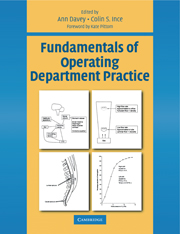Book contents
- Frontmatter
- Contents
- Contributors
- Preface
- Foreword
- Acknowledgements
- Introduction
- Chapter 1 The operating department practitioner, the patient and the law
- Chapter 2 Aspects of health and safety in the operating department
- Chapter 3 The caring practitioner
- Chapter 4 Strategies for infection control in the operating department
- Chapter 5 Sterilization, decontamination and the surgical field
- Chapter 6 The fundamentals of cardiovascular physiology
- Chapter 7 Fundamentals of respiratory physiology
- Chapter 8 Scientific principles in relation to the anaesthetic machine
- Chapter 9 Fundamentals of artificial ventilation of the lung
- Chapter 10 Scientific principles in relation to monitoring equipment
- Chapter 11 Scientific principles in relation to endoscopic, laser and radiological equipment
- Chapter 12 Pharmacological principles of drug administration
- Chapter 13 The pharmacology of drugs used in general anaesthesia
- Chapter 14 The local anaesthetic drugs - does the ideal agent exist?
- Chapter 15 The safe positioning of patients for surgery
- Chapter 16 Principles involved in the management and use of equipment
- Chapter 17 Understanding suture materials
- Chapter 18 Fundamentals ofpaediatric surgery and anaesthesia
- Chapter 19 Fundamentals of hyperthermia and hypothermia
- Chapter 20 Fundamentals of fluid and electrolyte balance during surgery
- Chapter 21 The physiology of blood and its administration
- Chapter 22 Fundamentals of pain relief
- Chapter 23 Fundamentals of dressings and drains in relation to wound healing
- Chapter 24 The recovery of patients from anaesthesia and surgery
- Chapter 25 Fundamentals of emergency and obstetric anaesthesia
- Chapter 26 Identification and management of anaesthetic emergencies
- Chapter 27 The fundamentals of emergency resuscitation
- Appendixes
- Index
Chapter 4 - Strategies for infection control in the operating department
Published online by Cambridge University Press: 05 October 2015
- Frontmatter
- Contents
- Contributors
- Preface
- Foreword
- Acknowledgements
- Introduction
- Chapter 1 The operating department practitioner, the patient and the law
- Chapter 2 Aspects of health and safety in the operating department
- Chapter 3 The caring practitioner
- Chapter 4 Strategies for infection control in the operating department
- Chapter 5 Sterilization, decontamination and the surgical field
- Chapter 6 The fundamentals of cardiovascular physiology
- Chapter 7 Fundamentals of respiratory physiology
- Chapter 8 Scientific principles in relation to the anaesthetic machine
- Chapter 9 Fundamentals of artificial ventilation of the lung
- Chapter 10 Scientific principles in relation to monitoring equipment
- Chapter 11 Scientific principles in relation to endoscopic, laser and radiological equipment
- Chapter 12 Pharmacological principles of drug administration
- Chapter 13 The pharmacology of drugs used in general anaesthesia
- Chapter 14 The local anaesthetic drugs - does the ideal agent exist?
- Chapter 15 The safe positioning of patients for surgery
- Chapter 16 Principles involved in the management and use of equipment
- Chapter 17 Understanding suture materials
- Chapter 18 Fundamentals ofpaediatric surgery and anaesthesia
- Chapter 19 Fundamentals of hyperthermia and hypothermia
- Chapter 20 Fundamentals of fluid and electrolyte balance during surgery
- Chapter 21 The physiology of blood and its administration
- Chapter 22 Fundamentals of pain relief
- Chapter 23 Fundamentals of dressings and drains in relation to wound healing
- Chapter 24 The recovery of patients from anaesthesia and surgery
- Chapter 25 Fundamentals of emergency and obstetric anaesthesia
- Chapter 26 Identification and management of anaesthetic emergencies
- Chapter 27 The fundamentals of emergency resuscitation
- Appendixes
- Index
Summary
PRINCIPLES OF INFECTION
We live in harmony with millions of microbes that exist in the environment, on our skin and in our alimentary tracts and mucous membranes. Very few of these micro-organisms are pathogenic (cause disease) and infection will only occur if there is an imbalance between the environment, the human host and commensal (normal) microbes.
Individuals requiring surgery are particularly vulnerable to infection. In most cases, invasive surgery breaches the physical barriers to infection (skin and mucous membranes) and also causes stress to the body, both psychologically and physiologically. A high level of stress is known to suppress the immune system, thus increasing the likelihood of postoperative infection.
Endogenous (self-infection) infection occurs if microorganisms that normally exist harmlessly in one part of an individual's body transfer to another site on the same individual where they can become pathogenic. Exogenous (cross-infection) infections are caused by pathogens from a source other than an individual's own body. To prevent cross-infection in theatres, staff must be committed to the implementation of an infection control strategy that seeks to achieve three aims:
To control or remove the organism.
To eliminate methods of cross-infection.
To protect the population from infection.
THE CHAIN OF INFECTION
The series of components that must be present for infection to occur have been described as the chain of infection. There are five links in this ‘chain’:
Source of infection.
Reservoir.
Mode of transmission.
Individual at risk.
Portal of entry.
Infection control is based on disrupting or breaking one or more links in the chain.
SOURCES OF INFECTION
The invading organism or causative agent is a microbe that may be a bacterium, virus, fungus or parasite.
RESERVOIR
This is the environment in which the organism thrives. There are three important reservoirs of infection within the operating department:
Humans (staff, patients and others).
Environment.
Equipment.
- Type
- Chapter
- Information
- Fundamentals of Operating Department Practice , pp. 35 - 42Publisher: Cambridge University PressPrint publication year: 1999
- 1
- Cited by

